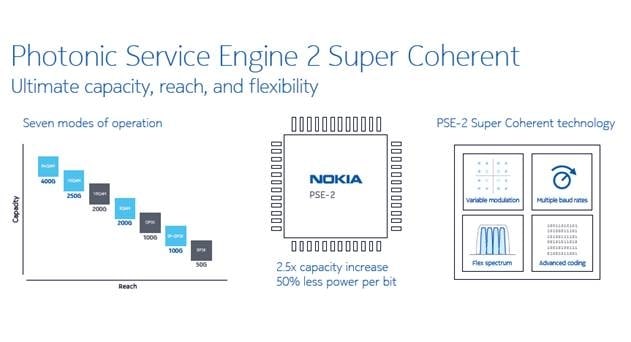Nokia and Facebook have collaborated on field trials of new optical digital signal processing technologies over a 5,500 kilometer transatlantic subsea link.
Transmission tests based on the commercially available Nokia Photonic Service Engine 2 (PSE-2) validated the successful transmission of 8-QAM wavelengths running at 200 Gb/s and 16-QAM wavelengths running at 250 Gb/s - a first for transatlantic transmission, claims Nokia.
As bandwidth-hungry applications such as video and virtual reality become accessible to more people around the world, scaling the telecommunications infrastructure that supports them is a significant challenge. To increase the capacity capabilities of subsea fiber, Nokia and Facebook tested Nokia Bell Labs' new probabilistic constellation shaping (PCS) technology.
The test showed an increase of almost 2.5x more capacity than the stated optical transmission capacity of the system, demonstrating the feasibility of the technology across a challenging real-world fiber-optic network.
PCS, an area of active Nokia Bell Labs research, is a novel technique that uses 'shaped' quadrature amplitude modulation (QAM) formats to flexibly adjust transmission capacity to near the physical limits of a given fiber-optic link.
In this first-of-its-kind experiment for an installed submarine link, conceived and planned by Facebook, PCS based on 64 QAM, combined with digital nonlinearity compensation and low-linewidth lasers, achieved a record spectral efficiency of 7.46 b/s/Hz, indicating the potential to upgrade this cable to 32 Tb/s per fiber in the future.
Dr. Stephen Grubb, Global Optical Network Architect, Facebook
This field trial with Nokia demonstrates that the scalable optical technology of PCS together with narrow linewidth laser sources can achieve capacities extremely close to the Shannon limit. This ensures that we are both maximizing our investment in submarine cable systems, as well as continuing to drive the cost per bit of submarine transport lower.
Sam Bucci, Head og Optical Networking, Nokia
By demonstrating promising areas of Nokia Bell Labs research such as PCS, as well as coherent technologies available today, we hope to chart a path forward for the industry towards higher capacities, greater reach, and more network flexibility.




















